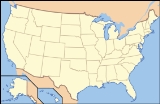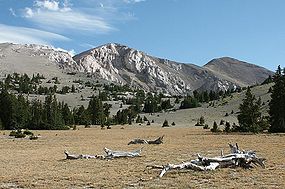
Mt. Moriah Wilderness
Encyclopedia
The Mt. Moriah Wilderness is a 89790 acres (363 km²) wilderness area in the northern part of the Snake Range
of White Pine County
, in the eastern section of the state of Nevada
in the western United States
.
The Mt. Moriah Wilderness was designated in 1989 and is administered by the Humboldt-Toiyabe National Forest
and the U.S. Bureau of Land Management, as some 8700 acres (35 km²) in the northern portion of the Wilderness lies on BLM land.
on its east flank and the Spring Valley
on the west. At 11000 feet (3,353 m) and stretching north and west of the peak is a unique plateau called the Table. Much of the area is composed of limestone
and shallow caves are common in the Wilderness.
scatters are found in the Wilderness.

The Mount Moriah Wilderness lies within the Intermountain
sagebrush
/ponderosa pine
ecosystem
and vegetation
varies with the elevation. Pinyon pine
and juniper
dominate the lower slopes, while aspen
, mountain mahogany, white
and Douglas fir, limber pine
, and bristlecone pine
are found in the upper elevations.
A variety of wildlife and fish species inhabit the Mt. Moriah Wilderness. The majority of the area is summer range for mule deer
, although some of the lower elevation benches and riparian areas are used year-round. Rocky Mountain bighorn sheep
can be found throughout the year in the area, as well as blue grouse
, sage grouse
, and chukar
. Rainbow trout
, brook trout
, and the unique Bonneville cutthroat trout
are found in the area's perennial streams, including Hampton Creek, Hendry's Creek, and Smith Creek.
Snake Range
The Snake Range is a line of high mountains in eastern White Pine County, in east-central Nevada in the western United States. Typical of other ranges in the Basin and Range Province, it runs in a north-south direction, in this case for approximately...
of White Pine County
White Pine County, Nevada
White Pine County is a county located in the U.S. state of Nevada. Its population at the 2010 census was 10,030. Its county seat is Ely. It is the home of Great Basin National Park...
, in the eastern section of the state of Nevada
Nevada
Nevada is a state in the western, mountain west, and southwestern regions of the United States. With an area of and a population of about 2.7 million, it is the 7th-largest and 35th-most populous state. Over two-thirds of Nevada's people live in the Las Vegas metropolitan area, which contains its...
in the western United States
United States
The United States of America is a federal constitutional republic comprising fifty states and a federal district...
.
The Mt. Moriah Wilderness was designated in 1989 and is administered by the Humboldt-Toiyabe National Forest
Humboldt-Toiyabe National Forest
The Humboldt-Toiyabe National Forest is the principal U.S. National Forest located in the U.S. state of Nevada. With an area of , it is the largest National Forest of the United States outside of Alaska...
and the U.S. Bureau of Land Management, as some 8700 acres (35 km²) in the northern portion of the Wilderness lies on BLM land.
Topography
Mount Moriah, the namesake of the Wilderness, rises 12050 feet (3,673 m) above the Snake ValleySnake Valley (Utah)
Snake Valley is a north-south trending valley that straddles the Nevada Utah border in the central Great Basin. It is bound by the Snake Range and the Deep Creek Mountains to the west and the Confusion Range to the east...
on its east flank and the Spring Valley
Spring Valley, Nevada
Spring Valley is an unincorporated town in Clark County, Nevada, United States located two miles west of the Las Vegas Strip. The population was 117,390 at the 2000 census.-Background:...
on the west. At 11000 feet (3,353 m) and stretching north and west of the peak is a unique plateau called the Table. Much of the area is composed of limestone
Limestone
Limestone is a sedimentary rock composed largely of the minerals calcite and aragonite, which are different crystal forms of calcium carbonate . Many limestones are composed from skeletal fragments of marine organisms such as coral or foraminifera....
and shallow caves are common in the Wilderness.
Archeology
Archaeological sites including caves utilized by Native Americans, pictographs, and lithicLithic Studies Society
The Lithic Studies Society was founded in 1979 to advance knowledge of, and education and research in, lithic studies. The Society's members have diverse interests, spanning Palaeolithic to historic periods across many areas of the world. The Society provides a convivial forum for the exchange of...
scatters are found in the Wilderness.
Vegetation

- See: Category: Flora of the Great Basin desert region
The Mount Moriah Wilderness lies within the Intermountain
Intermountain West
The Intermountain West is a region of North America lying between the Rocky Mountains to the east and the Cascades and Sierra Nevada to the west. It is also called the Intermountain Region.- Topography :...
sagebrush
Sagebrush
Sagebrush is a common name of a number of shrubby plant species in the genus Artemisia native to western North America;Or, the sagebrush steppe ecoregion, having one or more kinds of sagebrush, bunchgrasses and others;...
/ponderosa pine
Ponderosa Pine
Pinus ponderosa, commonly known as the Ponderosa Pine, Bull Pine, Blackjack Pine, or Western Yellow Pine, is a widespread and variable pine native to western North America. It was first described by David Douglas in 1826, from eastern Washington near present-day Spokane...
ecosystem
Ecosystem
An ecosystem is a biological environment consisting of all the organisms living in a particular area, as well as all the nonliving , physical components of the environment with which the organisms interact, such as air, soil, water and sunlight....
and vegetation
Vegetation
Vegetation is a general term for the plant life of a region; it refers to the ground cover provided by plants. It is a general term, without specific reference to particular taxa, life forms, structure, spatial extent, or any other specific botanical or geographic characteristics. It is broader...
varies with the elevation. Pinyon pine
Pinyon pine
The pinyon pine group grows in the southwestern United States and in Mexico. The trees yield edible pinyon nuts, which were a staple of the Native Americans, and are still widely eaten...
and juniper
Juniper
Junipers are coniferous plants in the genus Juniperus of the cypress family Cupressaceae. Depending on taxonomic viewpoint, there are between 50-67 species of juniper, widely distributed throughout the northern hemisphere, from the Arctic, south to tropical Africa in the Old World, and to the...
dominate the lower slopes, while aspen
Aspen
Populus section Populus, of the Populus genus, includes the aspen trees and the white poplar Populus alba. The five typical aspens are all native to cold regions with cool summers, in the north of the Northern Hemisphere, extending south at high altitudes in the mountains. The White Poplar, by...
, mountain mahogany, white
White Fir
White Fir is a fir native to the mountains of western North America, occurring at altitudes of 900-3,400 m. It is a medium to large evergreen coniferous tree growing to 25–60 m tall and with a trunk diameter of up to 2 m . It is popular as an ornamental landscaping tree and as a Christmas Tree...
and Douglas fir, limber pine
Limber Pine
The Limber Pine, Pinus flexilis, is a species of pine tree-the family Pinaceae that occurs in the mountains of the Western United States, Mexico, and Canada. It is also called Southwestern White Pine and Rocky Mountain White Pine...
, and bristlecone pine
Bristlecone pine
The bristlecone pines are a small group of pine trees that are thought to reach an age far greater than that of any other single living organism known, up to nearly 5,000 years....
are found in the upper elevations.
Wildlife
- See: Category: Fauna of the Great Basin desert region
A variety of wildlife and fish species inhabit the Mt. Moriah Wilderness. The majority of the area is summer range for mule deer
Mule Deer
The mule deer is a deer indigenous to western North America. The Mule Deer gets its name from its large mule-like ears. There are believed to be several subspecies, including the black-tailed deer...
, although some of the lower elevation benches and riparian areas are used year-round. Rocky Mountain bighorn sheep
Bighorn Sheep
The bighorn sheep is a species of sheep in North America named for its large horns. These horns can weigh up to , while the sheep themselves weigh up to . Recent genetic testing indicates that there are three distinct subspecies of Ovis canadensis, one of which is endangered: Ovis canadensis sierrae...
can be found throughout the year in the area, as well as blue grouse
Blue Grouse
The genus Dendragapus, contains two closely related species of grouse that have often been treated as a single variable taxon . The two species are the Dusky Grouse and the Sooty Grouse...
, sage grouse
Sage Grouse
The Sage Grouse is the largest grouse in North America, where it is known as the Greater Sage-Grouse. Its range is sagebrush country in the western United States and southern Alberta and Saskatchewan, Canada. A population of smaller birds, known in the U.S. as Gunnison Sage-Grouse, were recently...
, and chukar
Chukar
The Chukar Partridge or Chukar is a Eurasian upland gamebird in the pheasant family Phasianidae. It has been considered to form a superspecies complex along with the Rock Partridge, Philby's Partridge and Przevalski's Partridge and treated in the past as conspecific particularly with the first...
. Rainbow trout
Rainbow trout
The rainbow trout is a species of salmonid native to tributaries of the Pacific Ocean in Asia and North America. The steelhead is a sea run rainbow trout usually returning to freshwater to spawn after 2 to 3 years at sea. In other words, rainbow trout and steelhead trout are the same species....
, brook trout
Brook trout
The brook trout, Salvelinus fontinalis, is a species of fish in the salmon family of order Salmoniformes. In many parts of its range, it is known as the speckled trout or squaretail. A potamodromous population in Lake Superior are known as coaster trout or, simply, as coasters...
, and the unique Bonneville cutthroat trout
Bonneville cutthroat trout
The Bonneville cutthroat trout is a subspecies of cutthroat trout native to tributaries of the Great Salt Lake, U.S.A. Most of the fish's current and historic range is in Utah, but they are also found in Idaho, Wyoming, and Nevada...
are found in the area's perennial streams, including Hampton Creek, Hendry's Creek, and Smith Creek.
See also
- Nevada Wilderness AreasNevada Wilderness AreasIn 1989 the U.S. Government enacted the Nevada Wilderness Bill, expanding the one existing Wilderness Area and creating thirteen new areas...
- List of wilderness areas in Nevada
- List of U.S. Wilderness Areas
- Wilderness ActWilderness ActThe Wilderness Act of 1964 was written by Howard Zahniser of The Wilderness Society. It created the legal definition of wilderness in the United States, and protected some 9 million acres of federal land. The result of a long effort to protect federal wilderness, the Wilderness Act was signed...
External links
- Humbolt-Toiyabe National Forest: official Mount Moriah Wilderness website
- Friends of Nevada Wilderness: Mt. Moriah Wilderness
- Wilderness.net: Mount Moriah Wilderness
- GORP: Mt. Moriah Wilderness
- Trails.com: Nevada Hikes - Mount Moriah
- official Humboldt-Toiyabe National Forest website
- National Atlas: Map of Humboldt-Toiyabe National Forest

